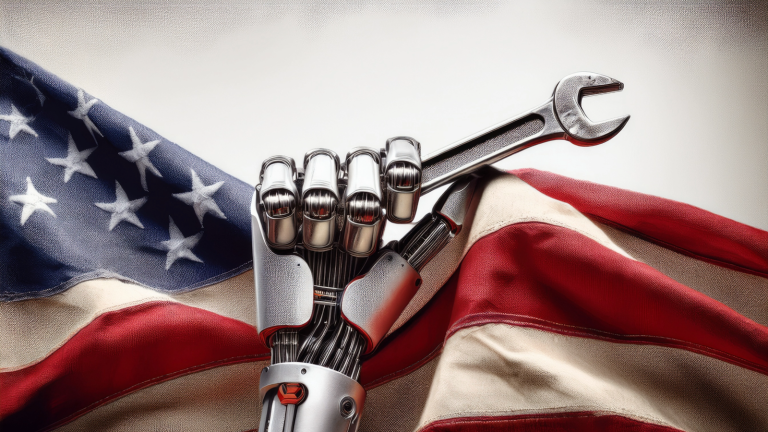Two months ago, the world changed – not with a whisper, but with a bang. President Donald Trump unleashed sweeping tariffs aimed at reshaping the global economic landscape.
What began with his “Liberation Day” announcement of universal tariffs has since evolved into a full-blown trade war, with America going toe-to-toe with China, the EU, Canada, Vietnam, and many other countries around the world.
To many, this moment looks like a risky threat; perhaps a massive policy blunder.
But we think that for smart investors, this perceived catastrophe is providing a great buying opportunity in the next decade’s market winners…
Because beneath the political posturing and violent market volatility – like Wall Street’s 10% down-days – something much bigger is brewing:
What we see as the rebirth of American industry and the dawn of a new industrial age; one powered not by steel or steam but AI-powered robots.
Welcome to the era of Physical AI.
The Big Idea: Reindustrialization Meets Robotics
Let’s unpack the strategy behind Trump’s aggressive trade policies.
We don’t think it’s just about squeezing China or enacting hefty tariffs for the sake of it.
Instead, it’s about reshoring – rebuilding American manufacturing; bringing the jobs, supply chains, and economic activity back home. And it seems that the president is all in.
Every tariff, press conference, and social media post all reinforces the same message: America First. American Made.
This is no longer just campaign rhetoric. It’s national policy.
But here’s the problem…
The path to bolstering U.S. manufacturing is hindered by the math.
For example, let’s talk wages.
American labor costs significantly more than labor in China or Vietnam. The U.S. minimum wage stands at $7.25/hour, compared to ~$3.50/hour in China and ~$1/hour in Vietnam.
That’s a 2x–7x labor cost premium – and it’s a major barrier to domestic manufacturing competitiveness.
So, how can the U.S. level the playing field?
How U.S. Trade Policy Is Fueling an AI Manufacturing Boom
This is where the AI robotics revolution enters the picture.
Because if you can’t compete with overseas wages using human laborers, you do so with machines.
Robots don’t need breaks, call in sick, unionize, or demand raises. In other words, they erase the labor cost differential.
And thanks to the incredible advances in AI, robotics, and automation, we now have the technology to revolutionize American manufacturing right now.
We’ve all seen the headlines about ChatGPT, Gemini, Claude, and other chatbots competing for the generative AI crown.
But that’s AI 1.0 – productivity restricted to digital spaces.
Now comes AI 2.0: embodied AI. Think humanoid robots that don’t just compute but physically act: walking, lifting, building, and problem-solving in the real world.
And this isn’t speculative anymore. It’s real. Consider:
- Tesla (TSLA) is leading the charge with Optimus, its humanoid robot that’s already performing tasks inside its factories.
- Nvidia (NVDA) just launched Project GR00T, a new suite of AI models built specifically for robotics use cases
- Meta (META) launched a humanoid AI division aimed at building the “iOS of robotics”
- Apple (AAPL) is investing in smart home robotics
- Alphabet (GOOG) is funding humanoid robotics startups like Apptronik
- OpenAI is exploring building its own robot
- Microsoft (MSFT) is backing Sanctuary AI, which just completed its first commercial delivery with a humanoid robot
Big Tech isn’t just watching. They’re investing aggressively.
And Wall Street is starting to follow.
Why Robotics and Automation Are Now Essential for U.S. Industry
Let’s tie this all together.
The U.S. government is now pursuing an economic strategy built on reindustrialization, supply chain security, domestic manufacturing, and economic sovereignty
But to pull it off in a globally competitive world? You need automation and robotics – AI in the real world.
With tariffs in place, trade deals being renegotiated, and the reshoring wave gaining steam, this strategy is already in motion. And the robotics arms race is officially on.
To achieve its economic goals, the U.S. will need to deploy millions of intelligent machines in warehouses, fulfillment centers, ports, airports, factories, fields, and construction sites.
In short, intelligent robots are now a national necessity.
And that creates a generational investment opportunity.
This won’t be a short-term hype cycle. This is a multi-year megatrend, with tailwinds from:
- National industrial policy
- Technological maturity
- Investor capital flows
- Supply chain security mandates
- Defense and military spending
- Federal subsidies and state incentives
In other words… this boom is just getting started.
And we’re not talking about buying Tesla stock to play this revolution. Instead, it’s time to home in on the next generation of AI 2.0 leaders.
Best Robotics Stocks to Watch in 2025
We’ve been closely tracking companies that we believe could be big winners in this Physical AI revolution for some time now. Here are some of the areas we’re watching:
1. Humanoid Robotics
- Companies building general-purpose, humanoid robots that can function in dynamic environments and directly replace human laborers
2. Industrial Automation & Logistics
- Robotics firms already powering warehouses and fulfillment centers, like Symbotic (SYM), whose tech is now being used across Walmart‘s (WMT) U.S. distribution network
3. AI Chipmakers & Sensor Firms
- The makes of these machines’ brains and eyes – companies that make the GPUs, LiDAR and vision sensors, and edge processors that enable real-world AI
4. Software Platforms for Robotics
- Just like iOS for iPhones, there will be a winner in “robot OS”: platforms that help control fleets of machines in coordinated workflows
5. Next-Gen Mobility
- Autonomous forklifts, robotaxis, and delivery bots, all of which are seeing rising demand in this post-globalization environment
The Final Word: A 21st-Century American Comeback
Tariffs, inflation, and market volatility may dominate today’s headlines.
But if you zoom out, you’ll see something much bigger unfolding.
America is rebuilding, powered by machines and guided by policy.
The trade war may have lit the match. But the fire now spreading across this country is an economic one, unleashing a new 21st-century Industrial Revolution powered by AI, fueled by necessity, and backed by policy.
If you’re an investor, this is your early-in moment…
Because we’re confident that in five years, everyone will be talking about robotics stocks the same way they talk about AI chip stocks today.
But by then, the easy money will have already been made.
So don’t wait.
When the winds of change start blowing, the best investors don’t build shelters. They build portfolios.
And the winds just picked up.
So, if you’re looking for the best AI 2.0 stocks to buy now…
See our top robotics stock pick for 2025.
On the date of publication, Luke Lango did not have (either directly or indirectly) any positions in the securities mentioned in this article.
Questions or comments about this issue? Drop us a line at langofeedback@investorplace.com.


